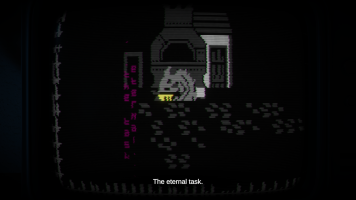General Information
Tormenture is a puzzle-horror game that truly immerses you. You play as a curious kid who bought a supposedly haunted game called Tormenture. The key thing to remember is you're a child playing Tormenture. You'll switch between 'reality' (interacting with your bedroom) and playing Tormenture on TV. The bedroom is simple - you can't move, only interact with nearby objects. When you use the TV, you'll see Tormenture full-screen, controlling a yellow square that moves between screens by touching area edges. If this sounds familiar, it's because Tormenture's look and gameplay are heavily inspired by (or perhaps copied from) Adventure (1978). When you start Tormenture, eerie text tells you to find four hidden relics and go north. You can tackle these relics in any order, which is great - if I got stuck in one area, I could make progress elsewhere. Each area has its own style and an item for solving puzzles: a torch, TV remote, magnet, and a shovel. Things get interesting when puzzles need two or more items. Figuring out how each item worked alone and together felt satisfying. There are also 34 secrets in Tormenture, with the toughest puzzles saved for these. They often need creative thinking, and while some took time to solve, I never felt frustrated.
There's not much to say about the story - the whole plot is on the Steam Store page. But I didn't mind this, as I got my narrative fix by uncovering the cursed game's details, especially the truth behind the four main bosses.
The visuals are simple but effective. The bedroom has a cozy, lived-in feel, while Tormenture itself captures the essence of early Atari games. The sound design is particularly noteworthy. The bedroom's ambient noises create a sense of unease, while Tormenture's audio is a mix of retro bleeps and unsettling tones that perfectly match the game's horror theme.
Tormenture isn't a long game - I finished it in about 3 hours. However, the clever puzzles and creepy atmosphere make it a memorable experience. It's a unique blend of nostalgia and horror that will appeal to fans of both genres.
In conclusion, Tormenture is a clever, creepy game that successfully merges retro gaming with modern horror elements. While it may not break new ground in storytelling, its engaging puzzles and immersive atmosphere make it worth playing. It's a reminder that sometimes, the games we play can play us back.
The connection between reality and Tormenture is a key feature. Some bedroom puzzles require actions in Tormenture, and vice versa. This link allows the game to affect reality, an intriguing concept that, while not frequent, feels impactful when it occurs. This feature brilliantly mirrors the real-life connection between games and reality, especially in 1980s gaming.
Older games often gave physical form to features we now take for granted. Tormenture follows suit. The in-game guide is a tangible book, supposedly packaged with the game, complete with a notes section containing hints from previous 'players.' The map is a notepad the kid scribbles on as you explore new areas. This attention to detail adds charm and deepens immersion, evoking memories of flipping through GameCube manuals as a child. For those who played classic games, the nostalgia factor must be off the charts.
On the horror front, Tormenture leans heavily on atmosphere, which is fortunate as other scare tactics fall short. The 8-bit style somewhat dampens the impact of in-game frights. While various monsters appear weird and unsettling, they're not particularly frightening. The real horror stems from a persistent sense of wrongness that permeates the game. This feeling is reinforced by encounters with off-putting NPCs, like one that only screeches when approached, or a large, sentient geode-like being that simply states, "I didn't move much."
The game's soundtracks, ranging from violent to ominous to sorrowful, complement this uneasy atmosphere perfectly. Throughout the game, I never felt at ease, which speaks to the effectiveness of its horror elements.
In essence, Tormenture succeeds in creating a deeply unsettling experience. While its visual scares may not always land due to the retro graphics, the game's ability to maintain a constant state of unease is commendable. The clever integration of reality and game world, coupled with nostalgic nods to gaming's past, creates a unique and engaging experience. Despite some limitations in traditional horror elements, Tormenture manages to deliver a consistently eerie atmosphere that keeps players on edge throughout their journey.
The child's room feels far from secure, with you placed at its center. A constant sense of vulnerability lingers, as if unseen entities could always dodge your gaze. Dismissing this unease became increasingly challenging when objects began to shift unseen. Letter blocks in the room rearrange themselves, forming different words seemingly at random, never spelling anything pleasant. Other toys, like the Speak & Spell - typically a harmless educational tool - take on a sinister twist. This particular device prompts spelling of words like 'demon' and 'mortality'. When asked for hints on tougher words, it ominously responds with 'something in the closet', suggesting a presence lurking just behind. From that moment, the closet remained under constant watch.
Tormenture offers a distinctive 'game within a game' experience, blending an unsettling atmosphere with inventive puzzles. Every aspect - visuals, audio, and gameplay - contributes to an immersive journey into an unfamiliar past. Its faithful recreation of the 80s era and direct inspiration from Adventure (1978) transforms it into a heartfelt tribute to classic video games. The game's ability to transport players to a time they may not have experienced firsthand is particularly noteworthy. Through its meticulous attention to detail and nostalgic elements, Tormenture not only entertains but also serves as a bridge between gaming's past and present, offering both longtime gamers and newcomers a unique perspective on the evolution of the medium.




